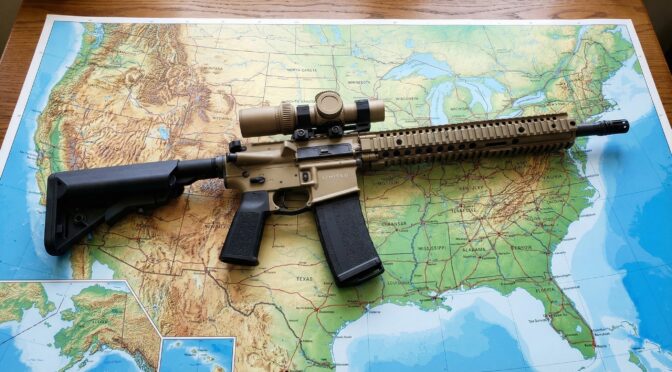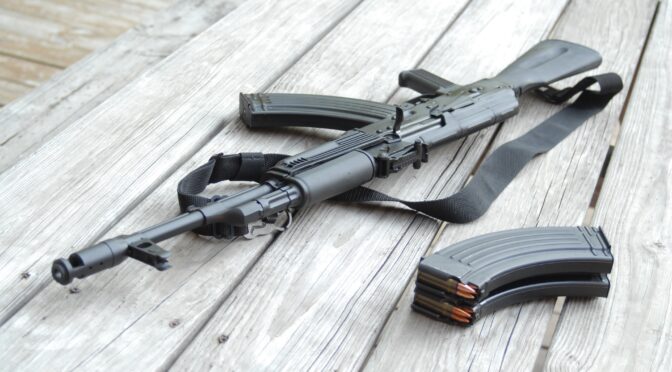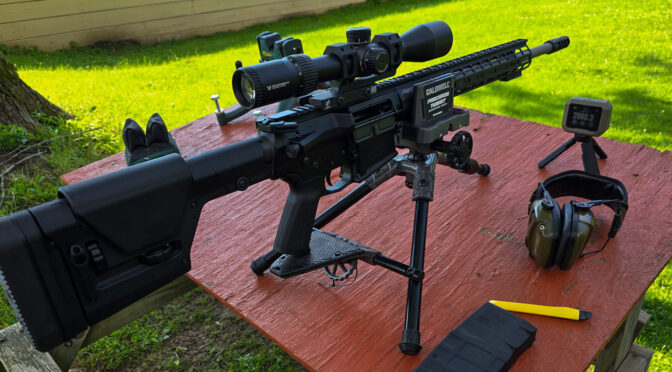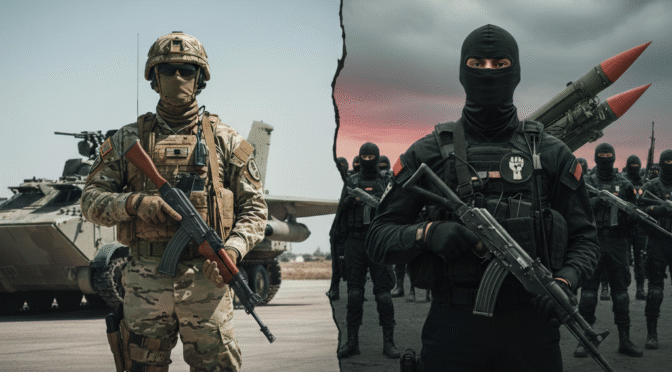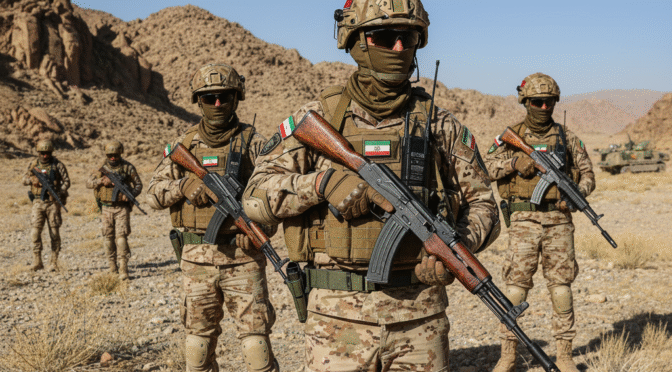The Daniel Defense “Eleanor” (SKU: LIMSER-031) represents a distinct and strategic insertion into the high-end consumer firearms market, positioned at the nexus of military procurement history, precision manufacturing, and collector exclusivity. This report provides an exhaustive technical and market analysis of the weapon system, which is marketed as the commercial realization of the specific configuration developed by Daniel Defense for the United Kingdom Ministry of Defence (MoD) “Project Hunter” trials. These trials were initiated to select a new Alternative Individual Weapon (AIW) system to replace the aging L85A2/A3 and L119A1/A2 fleets within the Royal Marines Commandos and the newly formed Ranger Regiment.
While the primary contract for the L403A1 system was ultimately awarded to Knight’s Armament Company (KAC) for the KS-1 platform, the release of the “Eleanor” provides the civilian market with a rare insight into the specific technical requirements of modern Tier 1 special operations forces. The system creates a unique value proposition through the integration of the Vortex AMG EBR-22L 1-10×24 Low Power Variable Optic (LPVO)—an optic notable for its domestic United States assembly and specific “hard-coat” Flat Dark Earth (FDE) anodization, a component typically restricted to government contracts and functionally distinct from the commercial Vortex Razor line.
This analysis evaluates the Eleanor not merely as a firearm, but as an integrated weapon system. It dissects the metallurgy and geometry of the M4A1 RII chassis, the optical engineering of the Vortex AMG, the financial implications of the $6,999 MSRP, and the comparative performance against peer-level platforms like the KAC KS-1. The findings suggest that while the Eleanor utilizes legacy chassis architecture compared to the contract winner, the inclusion of the restricted-availability optical system creates a localized market distortion that may justify the high acquisition cost for specific subsets of the collector market.
1. Geopolitical and Industrial Context: The “Project Hunter” Paradigm
To fully understand the technical configuration and market positioning of the Daniel Defense Eleanor, one must first analyze the geopolitical and industrial context of its origin: the United Kingdom’s urgent requirement to modernize its small arms capability through the Alternative Individual Weapon (AIW) system program.
1.1 The Operational Requirement: Beyond the Bullpup
For over three decades, the United Kingdom Armed Forces have relied on the SA80 (L85) bullpup platform. Despite extensive modernization programs led by Heckler & Koch (H&K) resulting in the A2 and A3 variants, the SA80 platform suffered from inherent architectural limitations. The bullpup design, while compact, presents significant challenges in ergonomic adaptability, particularly for left-handed shooters, and offers limited rail space for the integration of modern electro-optical devices and laser designators. Furthermore, the manual of arms for a bullpup is distinct from the AR-15/M4 pattern that has become the de facto standard for NATO special operations forces, creating interoperability friction during joint training and operations.
The “Project Hunter” initiative was launched to identify and procure a thoroughly modern Armalite Rifle (AR) platform to equip the Royal Marines Commandos—the UK’s elite amphibious infantry—and the newly established Ranger Regiment.1 The requirements for this new system were driven by the evolving nature of peer-state conflict and asymmetric warfare, necessitating a platform capable of:
- Signature Reduction: The requirement called for a “Rifle System” comprising not just the firearm, but a “Signature Reduction System” (suppressor) to mitigate flash and acoustic signatures, complicating enemy detection and targeting processes.1
- Optical Superiority: A decisive shift toward Low Power Variable Optics (LPVOs) with a 1-10x magnification range was mandated to bridge the capability gap between Close Quarters Battle (CQB) velocities and positive target identification and engagement at extended ranges (600-800 meters).1
- Ergonomics and Modularity: The tender specifically excluded bullpup configurations, demanding a rifle with the magazine well located in front of the trigger housing, coupled with fully ambidextrous controls to accommodate diverse firing positions and operator physiologies.1
1.2 The Industrial Competitive Landscape
The Project Hunter competition attracted submissions from the global defense industry’s apex manufacturers. Publicly acknowledged and rumored participants included:
- Knight’s Armament Company (KAC): Submitted the KS-1, a 13.7-inch rifle featuring their latest E3.2 bolt technology and a new URX6 rail system.
- Heckler & Koch: Submitted the HK416 A5, a piston-driven standard in Europe but heavier and more recoil-intensive than direct impingement alternatives.
- SIG Sauer: Submitted the SPEAR-LT, leveraging their modular MCX architecture.
- Glock: Submitted the GR-115F, a rare entry into the rifle market for the Austrian pistol giant.
- Daniel Defense: Submitted the configuration now released as the “Eleanor,” utilizing their combat-proven M4A1 RIS II architecture adapted to the British specification.1
The contract was ultimately awarded to Knight’s Armament Company for the KS-1, which was designated the L403A1 in UK service.1 The selection of the KS-1 highlighted a preference for the most advanced gas system and bolt geometry available, as well as a specific barrel profile designed to balance weight and thermal rigidity.
1.3 The Strategic Pivot: Monetizing the “Loss”
For Daniel Defense, the Eleanor release represents a strategic maneuver to monetize the substantial Research and Development (R&D) and proposal costs associated with the failed bid. By branding the rifle as “The one that got away” 3, Daniel Defense transforms a competitive loss into a marketing narrative of exclusivity. This approach capitalizes on the civilian market’s “Clone Culture”—a consumer segment dedicated to owning precise replicas of military-issued firearms. The Eleanor allows Daniel Defense to offer the exact configuration developed for the MoD, including the rare optical package, thereby validating their engineering effort in the eyes of the consumer despite the lack of a government contract. This strategy also serves to maintain brand prestige by positioning their platform as a finalist in a Tier 1 selection process, reinforcing the perception of “military-grade” quality.
2. Technical Engineering Analysis: The Host Platform (M4A1 RII)
The core of the Eleanor system is the Daniel Defense M4A1 RII, a platform with a lineage deeply rooted in the United States Special Operations Command (USSOCOM) SOPMOD Block II program. While the competitor KAC KS-1 utilized a novel chassis, the Daniel Defense submission relied on a legacy architecture refined over two decades of Global War on Terror (GWOT) service.
2.1 The Receiver Set: Material and Finish
The foundation of the Eleanor is a standard Mil-Spec upper and lower receiver set, CNC machined from 7075-T6 aluminum.3
- Metallurgy: 7075-T6 is the industry standard for high-stress aerospace and firearms applications due to its high strength-to-weight ratio and fatigue resistance.
- Surface Treatment: Unlike standard commercial rifles which are Type III Hard Coat Anodized black, the Eleanor receivers are finished in Cerakote H-199 Desert Sand.3
- Engineering Implication: Cerakote is a polymer-ceramic composite coating that offers superior corrosion resistance compared to anodizing in saline environments (crucial for Royal Marines operating in littoral zones). However, Cerakote adds a measurable thickness to the substrate (typically 0.0005″ to 0.001″). In precision interfaces, such as the mating surface between the upper receiver and the handguard or the barrel extension fitment, this added thickness must be accounted for to prevent tolerance stacking issues that could affect accuracy or rail alignment. The “Desert Sand” color is specifically formulated to match the anodized tone of the UK MoD specification, aiding in visual signature reduction in arid and mixed environments.
2.2 The Rail Interface System: RIS II Heritage
The defining structural element of the Eleanor is the Rail Interface System (RIS) II.3 Designed originally for USSOCOM in the mid-2000s, the RIS II was engineered to solve a specific problem: the requirement to free-float the M4 barrel while accommodating the M203 grenade launcher.
- Bolt-Up System Mechanics: The RIS II utilizes a proprietary Bolt-Up System, which sandwiches the upper receiver flange between the rail and a hardened steel barrel nut using six high-strength bolts.4
- Structural Rigidity: This design creates an incredibly rigid, continuous top rail that simulates a monolithic upper receiver. This rigidity is critical for the retention of zero on laser aiming modules (such as the PEQ-15 or NGAL) utilized for night fighting. Under the torque applied by a vertical foregrip, bipod loading, or barrier support, the RIS II exhibits minimal deflection compared to lighter, friction-fit rail systems.
- Thermal Dynamics: The quad-rail design acts as a massive heat sink. While this increases the thermal mass and surface area for cooling, it also makes the handguard uncomfortable to hold during sustained strings of fire without rail covers or gloves. The extensive machining required for the Picatinny rails (M1913 spec) on all four sides contributes to the system’s higher weight compared to modern M-LOK equivalents like the RIS III or KAC URX6.
2.3 Barrel Technology: Profile and Performance
The barrel is the primary determinant of the system’s terminal performance and lifecycle. The Eleanor features a 14.5-inch Chrome Moly Vanadium (CMV) steel barrel.3
- Manufacturing Process: The barrel is Cold Hammer Forged (CHF). In this process, a mandrel containing the negative impression of the rifling is inserted into the barrel blank, and massive hydraulic hammers compress the steel around it.
- Metallurgical Benefit: This process work-hardens the steel and aligns the grain structure along the axis of the bore. The result is a barrel with exceptional durability and resistance to throat erosion under high rates of fire, significantly outlasting button-rifled or cut-rifled barrels in operational lifecycles.
- Chrome Lining: The bore is chrome-lined. Chrome lining provides a hard, corrosion-resistant surface that protects the steel from the hot, high-pressure gases of combustion and the friction of the projectile. While historically associated with a slight degradation in absolute accuracy potential compared to stainless steel match barrels, modern manufacturing techniques by Daniel Defense have mitigated this, allowing for consistent 1.0 – 1.5 Minute of Angle (MOA) performance.5
- Profile Selection: The specifications indicate an M4 Profile barrel.4
- Critical Engineering Critique: The M4 profile is characterized by a distinctive “cutout” forward of the gas block, a vestigial design feature originally intended to mount the M203 grenade launcher. From a physics perspective, this profile is suboptimal for a precision “Recce” rifle. It removes material from the barrel where rigidity is needed (to counteract “barrel whip”) and places weight toward the receiver. In contrast, the winning KAC KS-1 utilizes a “medium-heavy” dimpled barrel profile. The dimpling increases surface area for cooling while reducing weight without sacrificing the structural stiffness required for consistent harmonics, especially when a suppressor is attached. The retention of the M4 profile on the Eleanor suggests a prioritization of supply chain commonality or strict adherence to a specific (perhaps earlier) iteration of the MoD requirement, rather than the absolute optimization of the platform for precision fire.
2.4 Gas System Dynamics: The Carbine Compromise
The Eleanor utilizes a Carbine-length gas system.3 This is a significant point of divergence from modern commercial trends and the KAC KS-1.
- Dwell Time and Pressure: On a 14.5-inch barrel, the distance from the gas port to the muzzle determines the “dwell time”—the duration the bullet remains in the barrel after passing the gas port, maintaining pressure to cycle the action.
- Carbine System: Provides a longer dwell time and higher port pressure. This results in a sharper, more violent recoil impulse and higher bolt carrier velocity.
- Mid-Length System: Used on the KAC KS-1 and Daniel Defense’s own civilian M4A1 RIII 6, the mid-length system moves the gas port forward. This reduces dwell time and pressure, resulting in a smoother recoil impulse, reduced wear on the extractor and bolt lugs, and less gas blowback when suppressed.
- Operational Rationale: The choice of a carbine gas system for the Eleanor is likely driven by a requirement for absolute reliability under adverse conditions. A slightly “over-gassed” carbine system ensures the weapon will cycle even when heavily fouled with carbon, lacking lubrication, or firing underpowered ammunition in extreme cold. While less pleasant to shoot than a tuned mid-length system, it offers a wider envelope of reliability—a trade-off often accepted in military procurement.
2.5 Muzzle Device and NFA Compliance
The barrel is tipped with a Dead Air Xeno Flash Hider, which is pinned and welded (P&W) to the barrel.3
- Legal & Technical Integration: The P&W process permanently attaches the muzzle device, bringing the total barrel length to over 16 inches. This classifies the Eleanor as a standard rifle rather than a Short Barreled Rifle (SBR) under US National Firearms Act (NFA) regulations, avoiding the $200 tax stamp and registration delays for the civilian buyer.
- Xeno System Mechanics: The Xeno mount utilizes a left-hand thread and a taper interface.
- Taper Physics: The taper ensures that as the suppressor is tightened, it self-centers, guaranteeing concentricity between the suppressor bore and the bullet path. This is critical to preventing “baffle strikes,” where the bullet clips the internal structure of the suppressor.
- Thread Geometry: The left-hand threads on the mount ensure that if the suppressor becomes stuck (carbon locked) and the operator applies torque to remove it, the muzzle device tightens against the barrel rather than unscrewing from it. This is a common failure point with right-hand threaded mounts.
3. Optical Systems Analysis: The Vortex AMG EBR-22L
The Vortex AMG EBR-22L 1-10×24 is the defining component of the Eleanor package and arguably the primary driver of its high cost. It is imperative to distinguish this specific optic from the commercially available Vortex Razor HD Gen III 1-10x, as they are distinct operational systems.
3.1 Manufacturing Provenance: The Berry Compliance Factor
- Commercial Standard: The standard Vortex Razor HD Gen III is manufactured in Japan.7 Japanese optics facilities (such as Low Light Optical) are world-renowned for their glass quality and precision, producing top-tier scopes for brands like Nightforce and March.
- The Eleanor Special (AMG): The AMG (Advanced Manufacturing Group) variant included with the Eleanor is assembled in the United States.8
- Strategic Relevance: This shift to domestic assembly is driven by strict military procurement regulations, such as the Berry Amendment (10 U.S.C. 2533a), which often mandate that sensitive components for key defense contracts be produced domestically to ensure supply chain security in the event of global conflict. For the civilian collector, a “Made in USA” marking on a high-end optic is a significant multiplier of value and rarity, as Vortex rarely releases these government-contract overruns to the public.
3.2 Optical Physics and Architecture
The AMG EBR-22L is a First Focal Plane (FFP) Low Power Variable Optic (LPVO) with a 1-10x magnification range and a 24mm objective lens.
- Exit Pupil Constraints: The laws of optical physics impose strict limitations on high-magnification scopes with small objective lenses. The exit pupil—the beam of light delivering the image to the shooter’s eye—is calculated as the objective diameter divided by the magnification.
- Calculation: $24mm / 10x = 2.4mm$.
- Operational Impact: A 2.4mm exit pupil is extremely restrictive. It requires the shooter to maintain perfect head alignment behind the optic. Any misalignment results in “scope shadow” or a complete loss of the image. This makes the 10x setting slower to acquire than the 1x setting, necessitating a consistent cheek weld (aided by the SOPMOD stock).
- Physical Architecture: The AMG is engineered to be lighter and shorter than its Japanese-made counterpart. Reviews indicate the AMG is approximately 19 ounces and 8.4 inches long, compared to the 21.5 ounces and 10.1 inches of the commercial Gen III.8
- Weight Savings: This reduction is achieved through aggressive machining of the 7075-T6 aluminum main tube (34mm diameter) and housing. In a “Recce” rifle role, where the operator is carrying the weapon over complex terrain, every ounce saved on the optic allows for more ammunition or water to be carried.
3.3 The “Anodized FDE” Manufacturing Challenge
The Eleanor optic features a Type III Hardcoat Anodized Flat Dark Earth finish.3
- Process Complexity: Anodizing aluminum to a consistent cosmetic color is notoriously difficult. The process involves an electrochemical bath that grows an aluminum oxide layer on the surface, which is then dyed. Variations in the aluminum substrate alloy, the temperature of the bath, the voltage applied, and the duration of immersion can all shift the final color from gold to brown to green. Achieving a “color match” to the UK MoD specification implies a high rejection rate during manufacturing, as units that do not meet the strict color criteria are discarded or refinished. This inefficiency significantly increases the unit cost of the optic, contributing to the system’s high price point.
3.4 Reticle Design: EBR-9/22L
The optic utilizes a “Christmas Tree” style reticle (EBR-9 variation).9
- Functionality: This reticle design provides a central aiming point surrounded by a grid of subtensions (hash marks) for windage and elevation holds. This allows the shooter to engage targets at varying distances without manually adjusting the turrets (“holding over” vs. “dialing”). For a Designated Marksman operating in dynamic environments, this speed is essential. The FFP nature of the optic ensures that these subtensions remain accurate at any magnification setting, unlike Second Focal Plane (SFP) optics where they are only valid at max power.
4. Systems Integration and Ancillary Components
The Eleanor is marketed as a “turnkey” system—a complete weapon package ready for deployment immediately out of the box. This integration mimics the military procurement model, where the rifle, optic, mount, and accessories are validated as a single unit.
4.1 Mounting Interface: Ruff’s Precision Delta Series
The optic is secured to the receiver via a Ruff’s Precision Manufacturing (RPM) Delta Series Cantilever Mount.3
- Structural Integrity: These mounts are machined from 6061-T6 aluminum and feature a cantilever design.
- Mechanism: The cantilever geometry pushes the optic mounting rings forward of the receiver base. This is necessary on the AR-15 platform to obtain the correct eye relief (distance from eye to ocular lens) while keeping the mount attached solely to the upper receiver. “Bridging” the mount across the receiver and the handguard is a critical failure mode, as handguard flex can shift the point of aim. The RPM mount prevents this.
- Market Value: These mounts retail for approximately $230 10 and are highly regarded for their clamping force and return-to-zero capabilities, aligning with the “Made in USA” theme of the optical package.
4.2 Furniture Ergonomics: B5 Systems
The rifle is equipped with the B5 Systems SOPMOD Stock and Type 23 Grip.4
- SOPMOD Stock History: The B5 SOPMOD is a direct descendant of the Crane Naval Surface Warfare Center (NSWC) design developed for the SOPMOD program. Its distinct triangular profile provides a wide, sloped surface for a cheek weld.
- System Synergy: This wide cheek weld is not merely for comfort; it provides the stability necessary to maintain head alignment within the tight 2.4mm exit pupil of the Vortex AMG at 10x magnification. The stock also features watertight storage tubes, allowing the operator to carry spare CR2032 batteries for the optic’s illumination or replacement bolt parts.
- Type 23 Grip: This grip features a steeper vertical angle compared to the traditional A2 grip. This improved angle reduces strain on the shooter’s wrist when the rifle is held in a compressed shooting position or when wearing body armor with a shorter length of pull.
4.3 Fire Control Group: The Trigger Controversy
The specifications list a Daniel Defense Enhanced Trigger.3
- Technical Critique: This component represents the most significant point of contention in the system’s value analysis. The DD Enhanced Trigger is a polished Mil-Spec component. While reliable and safer than a competition trigger for duty use, it lacks the crisp break, short reset, and lighter pull weight of a match-grade 2-stage trigger like the Geissele SSA or SSA-E.
- Comparative Deficit: Previous Daniel Defense Limited Series rifles, such as the “Desert Sage” or “M81 V1,” explicitly included Geissele SSA triggers.11 The omission of a $240 Geissele trigger in a rifle with a nearly $7,000 MSRP is a notable value subtraction. It forces the end-user to potentially upgrade the fire control group immediately, adding cost to an already premium purchase.
5. Comparative Systems Analysis
To determine the true market standing of the Eleanor, it must be benchmarked against both its direct inspiration (the KAC KS-1) and its internal competition (the standard DD M4A1 RIII).
Table 1: Technical Comparison Matrix
| Feature | DD “Eleanor” (Limited Series) | KAC KS-1 (L403A1) | DD M4A1 RIII (Standard) |
| Price (MSRP) | ~$6,999 | ~$3,000 – $5,000 (Est.) | ~$2,300 |
| Barrel System | 14.5″ CHF M4 Profile | 13.7″ Dimpled Medium-Heavy | 14.5″ CHF Gov/M4 Profile |
| Rail System | RIS II (Quad Rail) | URX6 (M-LOK/Hybrid) | RIS III (M-LOK) |
| Gas System | Carbine Length (DI) | Mid-Length (Sealed/Optimized) | Mid-Length (DI) |
| Optic | Vortex AMG 1-10x (US) | Vortex AMG 1-10x (US) | None |
| Muzzle Device | Dead Air Xeno | KAC QDC/MCQ-PRT | DD Flash Hider |
| Lower Receiver | Std. w/ Ambi Safety/CH | Fully Ambidextrous | Fully Ambidextrous |
| Bolt Technology | Mil-Spec Carpenter 158 | KAC E3.2 (Rounded Lugs) | Mil-Spec Carpenter 158 |
5.1 Eleanor vs. KAC KS-1: The Reality Check
The Knight’s Armament KS-1 is objectively a superior mechanical platform.
- Bolt Engineering: The KAC E3.2 bolt features rounded locking lugs and a dual-spring extractor, eliminating the stress risers found on standard square-lugged AR bolts. This significantly extends the service life of the bolt, the most common failure point in the AR system.12 The Eleanor uses a standard Mil-Spec bolt geometry.
- Gas & Barrel: The KS-1 uses a tuned mid-length gas system and a sealed gas block, optimized for suppressor use. Its dimpled barrel reduces weight while maintaining stiffness. The Eleanor relies on the older carbine gas system and standard M4 profile.
- Controls: The KS-1 features a fully ambidextrous lower receiver, including bolt catch and release on the right side. The Eleanor, based on the snippet description of “Radian Controls” 4, likely utilizes a standard lower with an ambi safety and charging handle, but lacks the ambi bolt controls found on the KS-1 or even the standard DD4 RIII.
5.2 Eleanor vs. Standard M4A1 RIII
Ideally, a limited edition should outperform the standard line. However, the standard Daniel Defense M4A1 RIII arguably offers a better shooting experience.
- Modernity: The RIII features the RIS III rail (M-LOK), which is lighter and slimmer than the RIS II quad rail. It also utilizes a Mid-Length gas system 6, providing a softer recoil impulse than the Eleanor’s carbine system.
- Conclusion: The Eleanor is purchased for the provenance and the optic, not for having the absolute latest innovations in gas dynamics or ergonomics. It is a “Clone” rifle, prioritizing adherence to a specific spec sheet over modern optimization.
6. Market Dynamics and Financial Valuation
The MSRP of $6,399 – $6,999 represents a massive capital outlay. To assess if this is “price gouging” or “value,” a component-level breakdown is required.
Table 2: Component Valuation Breakdown (Estimated Street Prices)
| Component | Estimated Market Value | Notes |
| Base Rifle (M4A1 RII) | $2,200 | Based on commercial M4A1 pricing |
| Vortex AMG 1-10x (FDE) | $3,500 – $4,500 | The Multiplier. Commercial Razor is ~$2.5k. This is a limited US-made variant. |
| RPM Mount | $230 | 10 |
| Dead Air Xeno (P&W) | $150 | Mount + Labor for Pin & Weld |
| Furniture/Controls | $300 | B5 Stock/Grip, Radian CH/Safety |
| Cerakote/Assembly | $300 | Custom finish premium |
| Pelican Case | $300 | Custom foam cut |
| Total “Sum of Parts” | ~$6,980 – $7,980 |
6.1 The “Unobtainium” Optic Factor
The financial viability of the Eleanor rests entirely on the valuation of the Vortex AMG optic.
- Scarcity Value: Snippets indicate the optic is considered “unobtainium”.13 In the secondary market, where clone builders pay premiums for exact military-correct parts, this scope alone could command prices exceeding $4,000. It is the only way to acquire the specific optic utilized by the UK Rangers without enlisting.
- Arbitrage Opportunity: It is highly probable that some buyers will purchase the Eleanor, strip the optic to sell on platforms like GunBroker or TacSwap for a massive premium, and keep the rifle as a “free” or heavily discounted asset.
6.2 Investment Outlook
Limited Series rifles from Daniel Defense, such as the “Alpine Predator” or “M81,” generally hold their retail value but do not see the explosive appreciation of KAC or HK products.14 However, the Eleanor is unique. Because the optic is chemically and mechanically distinct from commercial offerings, the package possesses a hedge against depreciation that other aesthetic-only limited runs lack.
7. Operational Performance Analysis
Beyond the specs and the money, how does the system perform in the field?
7.1 Ballistics and Terminal Efficacy
The 14.5-inch barrel is the “Goldilocks” length for the 5.56 NATO cartridge.
- Velocity: Firing MK262 (77gr) ammunition, the Eleanor will generate approximately 2,550 – 2,600 fps at the muzzle. This is sufficient velocity to ensure projectile fragmentation and reliable terminal effects out to 300-400 meters, with point-target engagement capabilities extending to 600 meters using the 10x optic and the Christmas tree reticle.5
- Twist Rate: The 1:7 twist rate is optimized for these heavy, 70gr+ projectiles, ensuring stability through the transonic zone.
7.2 Handling Characteristics
The Eleanor is not a lightweight system.
- Weight Distribution: The RIS II rail is heavy. The Vortex AMG, while light for its class, adds mass high on the rifle. With a suppressor, light, and laser added, the center of gravity shifts forward. This increases operator fatigue when keeping the rifle at the “high ready.”
- Recoil Impulse: Due to the carbine gas system and the lightweight Xeno flash hider (which offers no braking capability), the recoil will be “snappier” than a mid-length system with a muzzle brake. However, the weight of the system helps dampen this recoil, aiding in sight picture retention for rapid follow-up shots.
7.3 Operational Feedback Integration
Community discussions surrounding similar high-end builds highlight specific user preferences that the Eleanor addresses—and some it misses.
- Bipod Integration: Users building similar “Recce” rifles note that standard Magpul bipods can be “flimsy” and recommend upgrading to rigid systems like the AccuTac.16 The rigid RIS II rail of the Eleanor is the perfect host for such a heavy-duty bipod, providing a monolithic-like platform that won’t flex under “loading” (pushing forward into the bipod legs to manage recoil).
- Trigger feel: As noted in comparative discussions 17, the expectation for a rifle in this tier is a trigger that aids in precision fire. The heavy, creeping break of a standard DD trigger is a liability when trying to engage a 2 MOA target at 500 meters, forcing the shooter to fight the equipment.
8. Conclusion
The Daniel Defense Eleanor is a polarizing asset. It is a technically competent, battle-proven chassis mated to a world-class, rare optical system. However, it suffers from an identity crisis: it is a tribute to a British contract winner (KAC KS-1) built on a platform (M4A1 RII) that, while legendary, is two decades old in design philosophy.
Is it worth buying?
YES, IF:
- You are a High-End Optic Collector: You specifically want the US-assembled, FDE anodized Vortex AMG 1-10x. This package is likely the primary, if not exclusive, channel to acquire this optic. The rifle is essentially a delivery vehicle for the scope.
- You Prioritize “Bomb-Proof” Durability: The RIS II rail system is structurally stronger than modern lightweight M-LOK rails. If your operational reality involves heavy laser designators, barrier shooting, and rough handling, the M4A1 RII chassis remains the gold standard for rigidity.
- You are a Speculator: The “1 of 250” limit and the unique, chemically distinct optic ensure this rifle will not lose significant value. The breakout value of the components equals the MSRP, mitigating financial risk.
NO, IF:
- You Want the “Best” Shooting Rifle: For $7,000 (or even $3,500), a Knight’s Armament SR-15/KS-1 or an LMT MARS-L offers superior mechanical engineering (E3 bolts, monolithic uppers, fully ambi controls, tuned gas systems).
- You Want Modern Ergonomics: The RIS II is a “cheese grater” quad rail. It is heavy, wide, and abrasive. A standard DD M4A1 RIII offers better handling, a softer shooting mid-length gas system, and M-LOK modularity for $4,500 less (excluding optic).
- You Expect a Geissele Trigger: The inclusion of a standard DD trigger in a $7,000 rifle is an oversight that significantly degrades the precision shooting experience compared to the system’s price point.
Final Verdict: The Eleanor is an A-grade collectible due to its optical provenance, but a B+ grade shooter relative to its price tier due to legacy gas system and trigger choices. Its value is locked almost entirely in the scarcity of its optical payload.
Appendix A: Methodology
This report was compiled using a multi-layered Open Source Intelligence (OSINT) approach, synthesizing technical specifications, market data, and user sentiment to generate a comprehensive profile of the Daniel Defense Eleanor system.
- Technical Specification Verification: Primary source data from Daniel Defense product pages 3 and authorized retailer listings (Bereli, Freedom Trading) 4 was cross-referenced to establish the “hard specs” (barrel length, gas system, materials). Discrepancies, such as the exact nature of the trigger mechanism, were resolved by prioritizing specific SKU listings (LIMSER-031) over general brand marketing pages.
- Optical Systems Analysis: The specific model of the Vortex optic (AMG EBR-22L) was analyzed by comparing it to the standard commercial Razor HD Gen III. Technical reviews and video analysis 8 were utilized to identify physical differences (length, weight, assembly origin, turret design) to validate the “exclusive” nature of the component and its manufacturing origin.
- Comparative Market Analysis: Pricing data for the individual components (Scope, Mount, Rifle, Accessories) was aggregated from third-party vendors (MidwayUSA, EuroOptic, GunBroker) 10 to create a “Sum of Parts” valuation model. This allows for an objective assessment of the MSRP premium versus the street value of the constituent parts.
- Sentiment and Contextualization: Reddit threads 13 and forum discussions were mined to gauge the community reaction (“hype” vs. “disappointment”) and to identify specific user concerns regarding component selection (e.g., trigger quality, bipod selection). The “Project Hunter” military context was derived from defense industry reporting 1 to establish the narrative background of the firearm and its competitive positioning against the KAC KS-1.
- Synthesis: These data streams were integrated to form a holistic view of the weapon not just as a mechanical device, but as a financial asset and a historical artifact within the context of 2020s small arms procurement.
If you find this post useful, please share the link on Facebook, with your friends, etc. Your support is much appreciated and if you have any feedback, please email me at in**@*********ps.com. Please note that for links to other websites, we are only paid if there is an affiliate program such as Avantlink, Impact, Amazon and eBay and only if you purchase something. If you’d like to directly contribute towards our continued reporting, please visit our funding page.
Photo Source
The main blog image is based on one from Sportsmans Outdoor Superstore – they have a ton of great AR rifles to choose from.
Works cited
- Project Hunter: The UK’s New Assault Rifle – The Armourers Bench, accessed November 24, 2025, https://armourersbench.com/2023/09/06/project-hunter-the-uks-new-assault-rifle/
- Project Hunter – New Weapon System for British Forces : r/tacticalgear – Reddit, accessed November 24, 2025, https://www.reddit.com/r/tacticalgear/comments/1gtk2rs/project_hunter_new_weapon_system_for_british/
- Limited Series: ELEANOR – Daniel Defense, accessed November 24, 2025, https://danieldefense.com/limited-series-october-2025-eleanor.html
- Daniel Defense “ELEANOR” Custom 5.56mm M4A1 Carbine Rifle, Limited Edition, accessed November 24, 2025, https://www.bereli.com/limser-031/
- Daniel Defense M4A1 Block II Review – YouTube, accessed November 24, 2025, https://www.youtube.com/watch?v=AIRpadGG2YE
- Slim is in | Daniel Defense, accessed November 24, 2025, https://danieldefense.com/wire/slim-is-in
- Where Are Vortex Riflescopes Made? – Optics Trade Blog, accessed November 24, 2025, https://www.optics-trade.eu/blog/where-are-vortex-riflescopes-made/
- Vortex Razor AMG 1-10×24 – Eleanor – American made Excellence – YouTube, accessed November 24, 2025, https://www.youtube.com/watch?v=zw5KqFQMbhk
- Vortex Razor HD Gen III 1-10×24 FFP Riflescope, accessed November 24, 2025, https://vortexoptics.com/vortex-razor-hd-gen-iii-1-10×24-riflescope.html
- Delta Series Precision Cantilever, accessed November 24, 2025, https://www.rpmflg.com/products/delta-series-precision-cantilever
- Desert Sage Dealer Limited Series DDM4®V7® | Daniel Defense, accessed November 24, 2025, https://danieldefense.com/desert-sage-dealer-limited-series-ddm4v7.html
- DD or KAC : r/Danieldefense – Reddit, accessed November 24, 2025, https://www.reddit.com/r/Danieldefense/comments/18xtbig/dd_or_kac/
- DDM4 “Eleanor” : r/Danieldefense – Reddit, accessed November 24, 2025, https://www.reddit.com/r/Danieldefense/comments/1oy7qrq/ddm4_eleanor/
- Buy daniel defense v9 Online at GunBroker.com, accessed November 24, 2025, https://www.gunbroker.com/semi%20auto%20rifles/search?keywords=daniel+defense+v9
- Daniel Defense Mk12 Alpine Predator – Limited Series – For Sale :: Shop Online – Guns.com, accessed November 24, 2025, https://www.guns.com/search?keyword=daniel+defense+mk12+alpine+predator+-+limited+series
- Final form m4a1 14.5 : r/Danieldefense – Reddit, accessed November 24, 2025, https://www.reddit.com/r/Danieldefense/comments/1ik497x/final_form_m4a1_145/
- KAC or Daniel defense – Reddit, accessed November 24, 2025, https://www.reddit.com/r/kac/comments/18xsq91/kac_or_daniel_defense/
- Limited Edition Series Rifles | Daniel Defense, accessed November 24, 2025, https://danieldefense.com/limited-series
- Daniel Defense Limited Series M4A1 Eleanor with Vortex AMG Scope | SLW, accessed November 24, 2025, https://www.freedomtrading.com/daniel-defense-limited-series-m4a1-eleanor-p/limser-031.htm
- Daniel Defense M4A1 for Sale | Buy Online at GunBroker, accessed November 24, 2025, https://www.gunbroker.com/daniel-defense-m4a1/search?keywords=daniel%20defense%20m4a1&s=f&cats=3024
- Vortex Razor Gen III 1-10×24 EBR-9 MRAD Riflescope RZR-11002 – EuroOptic.com, accessed November 24, 2025, https://www.eurooptic.com/vortex-razor-gen-iii-1-10×24-ebr-9-mrad-riflescope-rzr-11002
